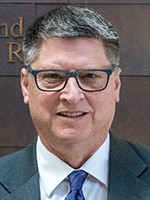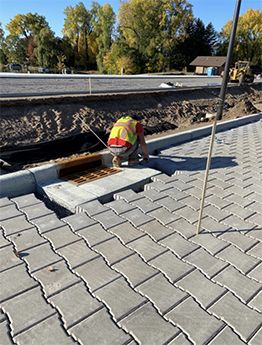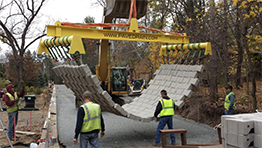
Mark Maloney known for national leadership in permeable pavement techniques
“To serve the public by making good, informed decisions—that’s just our job.” For Mark Maloney, the “job” has led to national leadership in permeable pavement techniques and statewide recognition for his dedication and service. A recent example of the latter is the 2023 Ray L. Lappegaard Distinguished Service Award from the Center for Transportation Studies.
Maloney, the public works director for the City of Shoreview since 1994, received the award at a May 1 ceremony in Minneapolis. The award honors outstanding leadership, mentorship, and support for the transportation profession.
In his storied career, Maloney has collaborated with University of Minnesota researchers and private industry to advance permeable pavement techniques that reduce the need for stormwater infrastructure and road salt. He has served as a member of one of MnLTAP’s sponsors—the Minnesota Local Road Research Board—and as the technical liaison for numerous LRRB-funded research projects. And he has been instrumental in the Local Operational Research Assistance Program, an LRRB program managed by MnLTAP.
Below, Maloney discusses permeable pavements and more.
How are Shoreview's permeable pavements performing?
In 2009, Shoreview replaced a conventional asphalt road nearly a mile long and 25 feet wide in the Woodbridge neighborhood with pervious concrete, which was chosen as the best option to effectively manage stormwater runoff from the site to nearby Lake Owasso.
It's been 13 years and the pervious pavements are still intact and generally functioning as intended. We had an extraordinary partnership with the concrete industry, the transportation research world, and contractors to achieve a remarkable result for the design and construction of that project. Since then, we’ve learned it may be hard to replicate that level of success for projects of our type, so starting in 2014, we moved away from pervious concrete and began using interlocking permeable block systems. We’ve used the systems in several public street segments, and we plan to continue to use them where they can help with drainage needs.
What are some benefits of permeable pavements?
The reason we keep using permeable pavements on public streets in Shoreview is because they help us solve drainage issues in a way that doesn't require retrofitting other types of infrastructure—for example, pipes, outlets, and ponds—that can require higher levels of maintenance and future public costs. It also seems like an appropriate and resilient response to the increased levels of precipitation we’ve experienced in recent years.

We used to have a pretty static idea of what set of parameters there would be for rainfall or snowfall or temperature. These days, we have to be mindful that’s changing. The wettest decade in recorded history was from 2008–2018. All the infrastructure that was in the ground at that time looked inadequate—it hadn’t been designed with that being even a remote possibility. What we’ve learned in the last few years, especially since the wet decade that ended in 2018, is that to do our jobs well, we need to be mindful of a different possible future.
How do the costs compare?
The beauty of permeable pavement is that, when necessary, the driving surface also serves as a drainage infrastructure. Instead of having completely different systems, a permeable pavement can do both things. On their face, permeable pavements seem expensive if you’re only comparing costs to those of traditional asphalt roadways. But to make it a fair comparison, you have to include all the costs you would normally spend to build catch basins, ponds, and other traditional stormwater infrastructure.
What's another highlight from your work?
Sidewalks and trails are very important to Shoreview, and we have aggressively built out a separate sidewalk and trail infrastructure. When I started in my career, most calls we received in winter were about street plowing. These days, anecdotally, we hear way more concerns and questions about sidewalk and trail maintenance than we do road maintenance. During the pandemic, people were struggling for ways to stay healthy and active, and having access to sidewalks and trails became a large issue. We learned that trails and sidewalks are so important to people’s lifestyle.
Closing thoughts?

When I graduated from the University of Minnesota, I never anticipated my career would bring me back to the U to be part of the transportation research model. But throughout my career, I had opportunities to work with CTS, LTAP, and civil engineering faculty, and I never really got away. And it’s a good thing. I can influence the research model and help us make some better infrastructure decisions in our community.
I had this idea when I was starting my engineering life that I would be sitting in an office or at a workstation designing things, and that was what was going to be satisfying and gratifying. That part of my career didn’t last very long. My career quickly turned into building relationships, and it’s an awesome thing. And then I started to understand that infrastructure was not a thing in and of itself—it was for people. Infrastructure is for our quality of life.
—Pamela Snopl, MnLTAP senior editor
Learn more:
- Permeable pavements could improve safety, benefit environment (MnLTAP, fall 2015)
- Seven Year Performance of City of Shoreview's Pervious Concrete Project (MnDOT, Dec. 2017)
- How Minnesotans Are Creating Infrastructure with Climate Change in Mind (WCCO News, March 3, 2022)